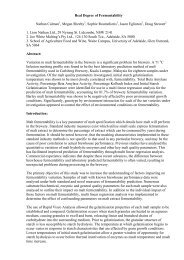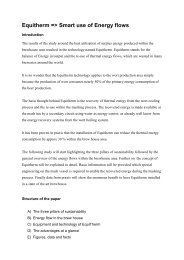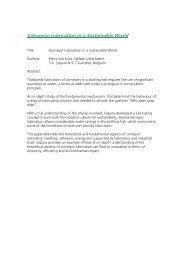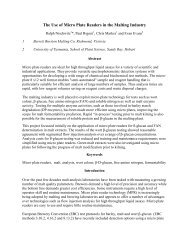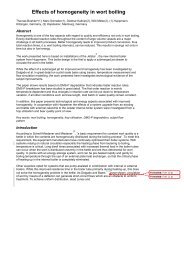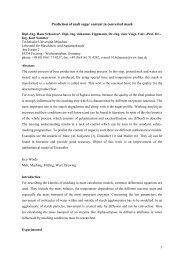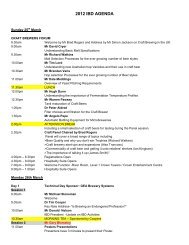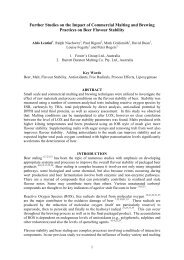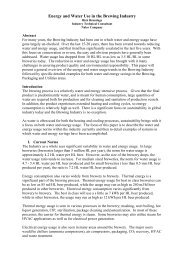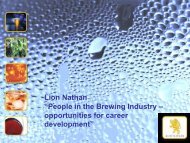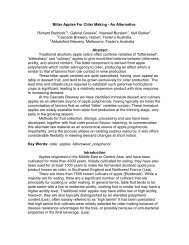Implementing World Class Manufacturing at Tooheys Brewery
Implementing World Class Manufacturing at Tooheys Brewery
Implementing World Class Manufacturing at Tooheys Brewery
You also want an ePaper? Increase the reach of your titles
YUMPU automatically turns print PDFs into web optimized ePapers that Google loves.
ContentsOverview ......................................................................................................................................... 3Introduction ..................................................................................................................................... 4The Process and Outcomes: <strong>Tooheys</strong> ............................................................................................. 5Leading and Managing Change: ................................................................................................. 55S: ............................................................................................................................................... 6Teamwork: ................................................................................................................................ 12Visual Management: ................................................................................................................. 13Focused Improvement:.............................................................................................................. 141. Found<strong>at</strong>ional FI........................................................................................................... 142. Focused Improvement Teams: .................................................................................... 15Standardised Work and Leader Standard Work........................................................................ 16Continuing Challenges and Opportunities .................................................................................... 18Conclusion .................................................................................................................................... 18
IntroductionWhilst the implement<strong>at</strong>ion of equipment upgrades can achieve a step change in cost reduction,there are a number of disadvantages in focusing on this approach to maintain competitiveness:there can be difficulties in justifying and raising capital, st<strong>at</strong>ed efficiency gains are rarelyrealized in full, equipment upgrades will often deterior<strong>at</strong>e without the appropri<strong>at</strong>e systems inplace to fully utilise, manage, maintain and oper<strong>at</strong>e and competitors can equally invest in suchcapital equipment and thus any advantage is lost. There are other reasons, these are just a few.To achieve sustainable improvement in competitiveness, it can be argued th<strong>at</strong> a brewery mustinvest in both equipment improvements and also in the improvements th<strong>at</strong> can be gener<strong>at</strong>ed by askilled, trained and motiv<strong>at</strong>ed work force applying the principles of lean manufacturing in theirday to day roles.Lean manufacturing, as applied in such systems as the MEX process, focuses on the applic<strong>at</strong>ionof familiar lean tools such as Six Sigma and structured problem solving, and also, the embeddingof the culture of continuous improvement in all aspects of the value chain. At its simplest, MEXis the ability to turn all teams into continuous improvement “engines”, working autonomously toimprove the infinite complexity of the complete brewing oper<strong>at</strong>ion. The focus of MEX is inembedding this capability in all of our people, building a self-sustaining management system andculture of continuous improvementThere have been many <strong>at</strong>tempts by numerous businesses to apply change to their business: in astudy highlighted in the book “Good to Gre<strong>at</strong>” by Jim Collins, only 11 out of 1435 organis<strong>at</strong>ionsinvestig<strong>at</strong>ed gener<strong>at</strong>ed sustainable performance improvements. In Lean initi<strong>at</strong>ives,implement<strong>at</strong>ion failures occur for numerous reasons, some of which include cherry pickingaspects of the lean process without full understanding of the whole process, and an inability orunwillingness to adopt a holistic approach to embed the principles of lean manufacturing, <strong>at</strong> alllevels of the organiz<strong>at</strong>ion, particularly the leadership team. Often, the most challenging change isfor leaders, who need to change the way they work. Typically leaders have lengthy experienceunderpinning their success, and changing the way they have achieved those results is difficult,sustaining those changes offers an even gre<strong>at</strong>er challenge.The MEX TRACC based process provides a complete system for the implement<strong>at</strong>ion of Lean<strong>Manufacturing</strong>, which will be described in further detail.
The Process and Outcomes: <strong>Tooheys</strong>The MEX process can be represented by the diagram below: the “Parthenon” model representsthe interdependency between each of the key elements of a successful implement<strong>at</strong>ion of leanmanufacturing using a familiar mental image, a building.Figure 1: ParthenonThe interdependency of the elements are depicted such th<strong>at</strong> we can see found<strong>at</strong>ion stones mustlay on a found<strong>at</strong>ion block, and the pillars can only be laid successfully on soundly embeddedfound<strong>at</strong>ions. This guides the builders of MEX to ensure th<strong>at</strong> solid, well connected found<strong>at</strong>ionsand pillars must be in place, and in order, before we can claim to have built a Parthenon of MEX.The key found<strong>at</strong>ions discussed are:1. Leading and Managing Change2. Teamwork3. 5S4. Visual Management5. Focused ImprovementLeading and Managing Change:This is the base found<strong>at</strong>ion block of the MEX process; the implement<strong>at</strong>ion of Lean requires th<strong>at</strong>the process is effectively led and managed by the site leadership team. Simply put, without thisfound<strong>at</strong>ion, the leadership team is unlikely to successfully support and steer a course through thechallenges of implementing <strong>Manufacturing</strong> Excellence. Many sites have been subjected to leanexercises which have failed due to the inability of leadership to sustain “Leading and ManageChange” and have then been c<strong>at</strong>egorized as “Flavour of the Month” exercises. The practical
applic<strong>at</strong>ion of this found<strong>at</strong>ion manifests in the daily, weekly and monthly meetings of the sitesenior leadership team. The team meets to seek gre<strong>at</strong>er depth of understanding of the MEXprocesses, review and reward the progress of various site teams and guide the site in theapplic<strong>at</strong>ion and understanding of each of the found<strong>at</strong>ions listed below. Commitment requires aminimum of 16 hours per month of the site senior leadership team purely focused on theimplement<strong>at</strong>ion of MEX.5S:5S is the principle of applying disciplined thought and disciplined action to the physical layoutand oper<strong>at</strong>ion of any area of the brewery, to allow value to flow. It requires the applic<strong>at</strong>ion of“5S’s” in their chronology. Briefly these are;1. “Sort”: the removal of unnecessary items from the workplace2. “Shine”: the “cleaning with meaning” to both improve the appearance (and morale andownership) of the area and allow the identific<strong>at</strong>ion of leaks or sources of contamin<strong>at</strong>ion3. “Set in Order”: this is the process by which required quantities of tools and m<strong>at</strong>erials areplaced in the most convenient and efficient loc<strong>at</strong>ion4. Standardise: this is the applic<strong>at</strong>ion of visual, self set standards by the team to ensurestandards are agreed, displayed and communic<strong>at</strong>ed in the area.5. Sustain: the process of auditing against standards and subsequent “continuousimprovement”The implement<strong>at</strong>ion of 5S <strong>at</strong> <strong>Tooheys</strong> posed a number of challenges: the site has previously<strong>at</strong>tempted hygiene exercises including cleaning days and even <strong>at</strong>tempts <strong>at</strong> giving ownership tocombin<strong>at</strong>ions of teams, team leaders and managers all <strong>at</strong> varying times and degrees of effort overthe last couple of decades. These initi<strong>at</strong>ives gener<strong>at</strong>ed minimal sustainable success, and littlemore than a residue of their existence remained in 2009. Indeed, elements of these initi<strong>at</strong>ives andothers implemented in the past became known as “signs of intelligent life”. This origin<strong>at</strong>ed fromthe principle th<strong>at</strong> team leaders would often find dusty folders and binders with reference tocleaning systems, setup time reduction initi<strong>at</strong>ives etc, which had been tried and applied in thepast by leaders long gone, yet little more than these paper remnants existed as evidence of theirexistence.The MEX process <strong>at</strong> <strong>Tooheys</strong> is focused on the principles of sustainability, not only in 5S but onall aspects of the implement<strong>at</strong>ion.5S has been rolled out in a number of areas of the <strong>Tooheys</strong> site, including significant areas ofBrewing and Packaging oper<strong>at</strong>ions, and most recently the Technical function completed 5Sthroughout the whole department. 5S has been rolled out in manageable areas where an 8 weeklimit is put on implement<strong>at</strong>ions. The scope of implement<strong>at</strong>ion is chosen to be achievable in thistimeframe. The timeframe has been chosen as it has been found to represent dur<strong>at</strong>ion wheremanageable change can be achieved without becoming a “drag” on morale (which long projectstend to be).The conclusion of all successful implement<strong>at</strong>ions (5S, VM, TW etc) is celebr<strong>at</strong>ed through a“Close Out” ceremony where all team members are invited to present to the leadership team,
followed by handshakes, informal discussion and questions and a round of pizza. A certific<strong>at</strong>e isalso signed by the Oper<strong>at</strong>ions Director and hung in the main entrance of the brewery (seepictures below).Place Close Out Document HereExample of a Closeout Document<strong>Tooheys</strong> Hall of Fame: Home of the CloseoutsThe following pictures and graph give some indic<strong>at</strong>ion of the successes seen. The graph depictsan independent site hygiene audit which has shown significant improvement since the
commencement of MEX. The improvements have also been observed and quantified through theaudits of insurance agencies and licensed brand owners who visit and evalu<strong>at</strong>e the site on aregular basis. Their most recent observ<strong>at</strong>ions and reports have highlighted the significantchanges in performance and appearance of <strong>Tooheys</strong> <strong>Brewery</strong>.5S is a significant focus of the <strong>Brewery</strong>. There is a firm belief in the philosophy th<strong>at</strong> without thesuccessful implement<strong>at</strong>ion of 5S, we will not be able to progress any other found<strong>at</strong>ions or pillarsof the TRACC process. 5S sustainability does (and will) remain a significant challenge in aworkplace with considerable m<strong>at</strong>erial and people movement in a 5*24 hour process with 3 shiftsteams.Practice and Premise GraphGraph of Improvement of Practice and Premises
Example of Team Activity Board For 5SPackaging Maintenance Workshop Prior to 5S
Packaging Maintenance Workshop After 5S
Process Services After 5S
Teamwork:This element of the Parthenon focuses on the establishment of effective teamwork in theworkplace. It has been shown th<strong>at</strong> individuals cope with change in a more effective manner whenin teams built specifically to progress the implement<strong>at</strong>ion of th<strong>at</strong> change. Teams should haveclear performance targets and be empowered with the right tools and training to achieve them.Teamwork <strong>at</strong> <strong>Tooheys</strong> has seen the development of leadership, engineering, oper<strong>at</strong>ions and othershift based teams, each of which have identities, visions and mottos. The teams also work towardself set goals built around PQCDSM. An example of a team board is shown below. Teams meetweekly and use these boards as a focus point for their discussions. Thus far, around 20 teamshave been set up with names such as “Team Karma”, “Enginebeers”, ‘Hectoleaders” and theimagin<strong>at</strong>ively titled “The <strong>Tooheys</strong> Leadership Team” (the author is part of this unimagin<strong>at</strong>ivelytitled cohort and accepts there may be room for improvement).Example of a Teamwork Board
Visual Management:Visual Management is the applic<strong>at</strong>ion of two separ<strong>at</strong>e themes Performance Measurement andVisual DisplayPerformance Measurement is a well used and often badly applied term, in the TRACCmethodology, it refers to measuring “the right things, the right way”. Th<strong>at</strong> is ensuring ourmeasuring focus is on the things th<strong>at</strong> will make a difference, aligned to the business plan,deployed to the appropri<strong>at</strong>e level. The “right way” is about the correct visual display, usingsimple rules such as any visual tool should allow a seven year old to identify of the measure ison/off track in 3 seconds and whether the trend is positive or neg<strong>at</strong>ive within 30 seconds, and beseen from 5 meters.The progress made <strong>at</strong> <strong>Tooheys</strong> has been significant. The author will <strong>at</strong>tempt to rel<strong>at</strong>e this to afootball or cricket analogy, (though cricket not being a strong point of this Scottish author).<strong>Tooheys</strong>, prior to MEX, would display the outcome of a simple sports game as a list of cornersand their times, free kicks and their offenders, referees pace of running etc. Th<strong>at</strong> is, long lists offactual d<strong>at</strong>a th<strong>at</strong> would take an expert to interpret and to find the actual outcome, and leave theplayers (machine oper<strong>at</strong>ors in our case) bamboozled and disengaged about daily productionoutcomes. Today the process has been simplified gre<strong>at</strong>ly to the concept of red or green, wherered equals action required and green confirms performance to target.This has been a significant improvement and, for example, allows 24 hours of running in a 3million hectoliter brewery by 210 FTE’s, to be reviewed and actioned (with substance) in daily15 minute meetings. The interaction with other found<strong>at</strong>ions, discussed <strong>at</strong> the start of the paper, isillustr<strong>at</strong>ed by the use of VM in 5S, Focus Improvement and Teamwork.<strong>Tooheys</strong> today, presents the results of the game as a simple score from which the team decideswhere improvements are required. In the author’s opinion cricket scores are never simple in anyguise with any tools.Some examples of visual management tools in action are shown below:
Example of Visual Management: Brewing T1 (Team level) MeetingExample of Visual Management: Brewing T2 (Department level) MeetingFocused Improvement:Focused improvement is the best practice of identifying major wastes and other priority areas inorder to focus all improvement activities on them. It will ensure th<strong>at</strong> appropri<strong>at</strong>e resources aretarget <strong>at</strong> the right areas to gener<strong>at</strong>e the maximum results. The “FI” TRACC has taken two forms,the first being “Found<strong>at</strong>ional” or infrastructure of improvement and the second being specific to“FIT’s”: Focus Improvement Teams which apply improvement tools such as “DMAIC” and “5Why”. These will be explored in gre<strong>at</strong>er detail below:1. Found<strong>at</strong>ional FIFound<strong>at</strong>ional FI rel<strong>at</strong>es to embedding the day to day and week to week infrastructure th<strong>at</strong>allows oper<strong>at</strong>ional performance review to improve it. These levels are denoted as “Tier 1”,“Tier 2” and “Tier 3” and rel<strong>at</strong>e to the hierarchy of importance in terms of gener<strong>at</strong>ing valueflow. Hence Tier 1, rel<strong>at</strong>es to shift based meetings and problem solving, T2 to departmentand T3 to Site leadership. The process allows the implement<strong>at</strong>ion of shift, daily and weeklymeetings. The meetings involve the review of “PQCDSM” items i.e. Production, QualityCost, Delivery, Safety and Morale in a 15 minute session th<strong>at</strong> uses Visual Management toallow a focus on areas where devi<strong>at</strong>ion from target occurs. The applic<strong>at</strong>ion of this structureallows daily incremental improvements.
Model of Tiered Approach to “Running” and “Improving” the Business2. Focused Improvement Teams:Focus Improvement Teams act <strong>at</strong> a number of different levels applying a set of structuredproblem solving tools. These teams gener<strong>at</strong>e significant improvements ( as opposed tothe incremental improvements of Found<strong>at</strong>ional FI) through the applic<strong>at</strong>ion of “DMAIC”:“Define”: clearly define the problem“Measure”: Measure the extent of the defined problem to establish a start point and toalso allow identific<strong>at</strong>ion of trends, reasons for issues“Analyse”: This is the applic<strong>at</strong>ion of “Fish Bone” analysis to identify the most significantsymptoms of the problem, the use of “5Whys” to drill down into the symptoms todetermine the root cause, and the applic<strong>at</strong>ion of a prioritis<strong>at</strong>ion m<strong>at</strong>rix to identify theeasiest root causes to fix“Control”: the applic<strong>at</strong>ion of permanent controls and checks to ensure the actions fromanalyse have bedded down.The DMAIC process has been applied in over 40 implement<strong>at</strong>ions, from reducing extractloss and elimin<strong>at</strong>ing jams <strong>at</strong> a bottle filler, to elimin<strong>at</strong>ing spilled yeast in a centrifugeroom (avoiding significant capital expenditure). The most powerful example to d<strong>at</strong>e is thereduction in safety incidents on site as a result of applying the DMAIC problem solvingtool set.
Graph Showing Significant Reduction in Lost Time InjuriesGraph Showing Significant Reduction in MTIFRStandardised Work and Leader Standard WorkA critical part of sustaining the processes detailed above is the implement<strong>at</strong>ion of “StandardWork” and “Leader Standard Work”. Standard work is shown below and is represented by a listof standard tasks required in a role to allow the flow of “value”. For a machine oper<strong>at</strong>or, this maybe the checking of reject r<strong>at</strong>es on an hourly basis, or a Brewhouse oper<strong>at</strong>or carrying out 5Sinspections on a shift basis.Leader Standard Work is the implement<strong>at</strong>ion of leadership confirm<strong>at</strong>ion th<strong>at</strong> the standard work isfunctioning and effective, it transl<strong>at</strong>es the focus on process into daily practices and routines. Itcre<strong>at</strong>es a structure to drive value added actions, identify and remove barriers and improve andaudit processes.
In practice, Standardised work secures the gains made by Improvement Activities such as FIT’sand 5S and ensures they are sustained. Leaders standard work, ensures the applic<strong>at</strong>ion ofstandard work, and also provides the structure to ensure these gains are secured and improveddespite personnel changes or process changes.The process provides the tool to prevent the previously describes “signs of intelligent life”scenario. The outcomes of improvement processes must gener<strong>at</strong>e standard work which enters the“running the business” structures (such as T1, T2, T3 daily meetings) to embed the gains andensure they are sustained, This is achieved by applying the principle of PDCA, “Plan Do CheckAct”, a constant cycle of improvement and locking in gains by applying standard oper<strong>at</strong>ingprocedures, standard work and leader standard work.Much more could be written and much more has still to be learned by the author about a practiceth<strong>at</strong> appears easy to grasp yet proves illusive in its consistent applic<strong>at</strong>ion. The diagrams below<strong>at</strong>tempt to show the rel<strong>at</strong>ionships and the practical outcome.PDCA CycleExample of Standard WorkRel<strong>at</strong>ionship between improvements and running the business
Continuing Challenges and OpportunitiesThe ongoing challenges are:1. Continue the roll out of the found<strong>at</strong>ions of the MEX process. Th<strong>at</strong> is, Leading andManaging Change, 5S, Teamwork, Visual Management and Focused Improvement, tocover further geographical areas and departments.2. Maintain and improving standards in completed implement<strong>at</strong>ions and ensuring theirsustainability (and th<strong>at</strong> of the MEX process).3. Begin the pilot implement<strong>at</strong>ion of the Pillars. Th<strong>at</strong> is, Autonomous Maintenance, AssetCare, Setup Time Reduction and Quality. As with the implement<strong>at</strong>ion of the found<strong>at</strong>ions,the challenge is to select the correct areas for Pilot implement<strong>at</strong>ions, areas th<strong>at</strong> will bothdeliver performance improvement and contain the elements of a successful andinfluential implement<strong>at</strong>ion: skill levels in place, correct levels of motiv<strong>at</strong>ion and businessleaders.Conclusion<strong>Tooheys</strong> has taken significant steps in implementing the found<strong>at</strong>ions required to build theParthenon of lean, achieving significant results in terms of performance and practices. Theauthor has only touched on the challenges and successes th<strong>at</strong> have been experienced inprogressing the MEX journey over the last 3 years: as st<strong>at</strong>ed in the introduction, the brewery, aswith most manufacturing facilities, has infinite complexity and when coupled with the nuancesof human n<strong>at</strong>ure, it can be seen th<strong>at</strong> the implement<strong>at</strong>ion of MEX is truly a significantundertaking. This year (2012) offers a huge challenge, with the planned implement<strong>at</strong>ion of over120 activities compared with 47 in 2011. Yet this presents the opportunity and <strong>at</strong>traction ofapplying the MEX process: the more implement<strong>at</strong>ions we do, the more value we add to ourbrewery and the more we learn. In addition our roles become more meaningful; it is theelimin<strong>at</strong>ion of waste th<strong>at</strong> drives the heart of the process, not only in dollar terms, but principallythe elimin<strong>at</strong>ion of waste in the applic<strong>at</strong>ion of human endeavor.



